一、Hystrix处理流程
Hystrix流程图如下:
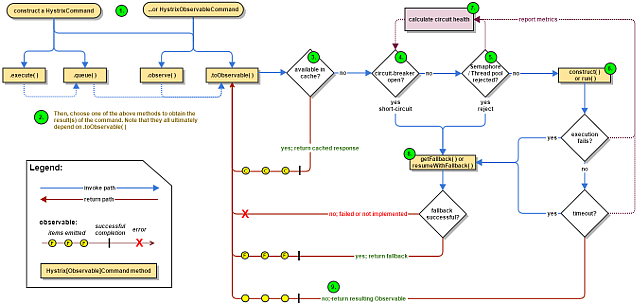
Hystrix整个工作流如下:
- 构造一个 HystrixCommand或HystrixObservableCommand对象,用于封装请求,并在构造方法配置请求被执行需要的参数;
- 执行命令,Hystrix提供了4种执行命令的方法,后面详述;
- 判断是否使用缓存响应请求,若启用了缓存,且缓存可用,直接使用缓存响应请求。Hystrix支持请求缓存,但需要用户自定义启动;
- 判断熔断器是否打开,如果打开,跳到第8步;
- 判断线程池/队列/信号量是否已满,已满则跳到第8步;
- 执行HystrixObservableCommand.construct()或HystrixCommand.run(),如果执行失败或者超时,跳到第8步;否则,跳到第9步;
- 统计熔断器监控指标;
- 走Fallback备用逻辑
- 返回请求响应
从流程图上可知道,第5步线程池/队列/信号量已满时,还会执行第7步逻辑,更新熔断器统计信息,而第6步无论成功与否,都会更新熔断器统计信息。
二、Hystrix的核心原理
hystrix在服务降级熔断的过程中有几个步骤他是必须要去完成的
- 可配置化的降级策略(根据不同的服务降级类型配置不同的降级策略方案):
- 三种方式:信号量/线程 、超时(默认1s)、熔断(错误率)
- 在HystrixCommandProperty类中通过相关属性去配置改变他的默认策略(上篇中有说明过)
- 可以识别的降级边界:
- @HystrixCommand(Spring AOP通过注解标注一个接口的资源,去表示说明这个接口需要通过Hystrix来接管这个请求,如果达到注解内的配置要求就熔断)
- 自己去继承HystrixCommand 抽象类,等下演示下,这玩意还挺好玩的
- 数据采集:
- 如何触发熔断(上篇幅也说过10s 内20个请求 ,错误率达到50),这里引出的问题是如何采集数据,如何统计数据.
- SEMAPHORE,最大并发数量 (它底层其实就是个AQS 统计次数tryAcquire(), acquire())
- 行为干预: 触发降级/熔断之后,对正常业务产生影响
- 结果干预: 通过fallback()返回数据
- 自动恢复(处于熔断状态下,会每隔5s尝试去恢复)
2.1、通过HystrixCommand 接管我们定义的请求
上一篇幅我是通过注解的方式来进行服务熔错的,这次不通过注解换一种方式,首先在spring-cloud-user服务中写以下内容
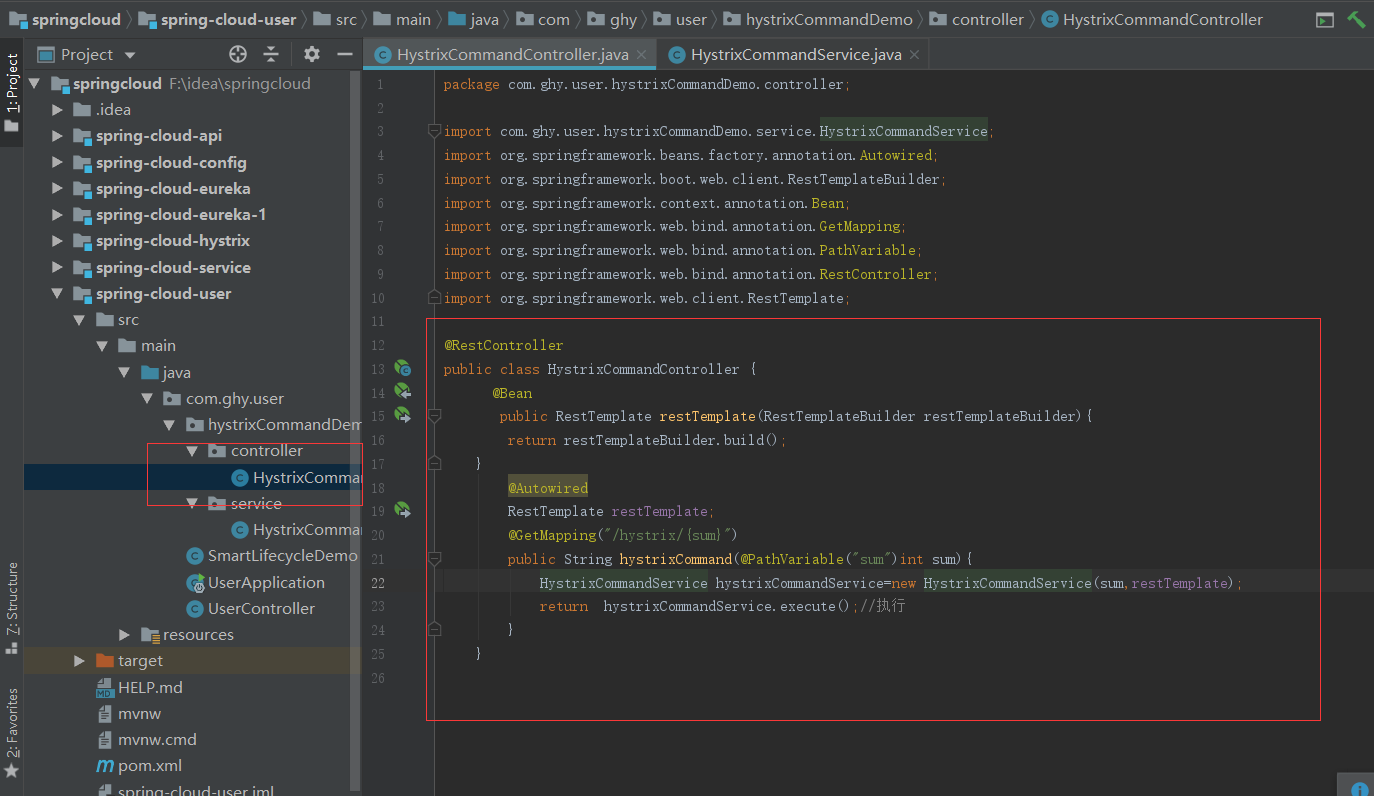
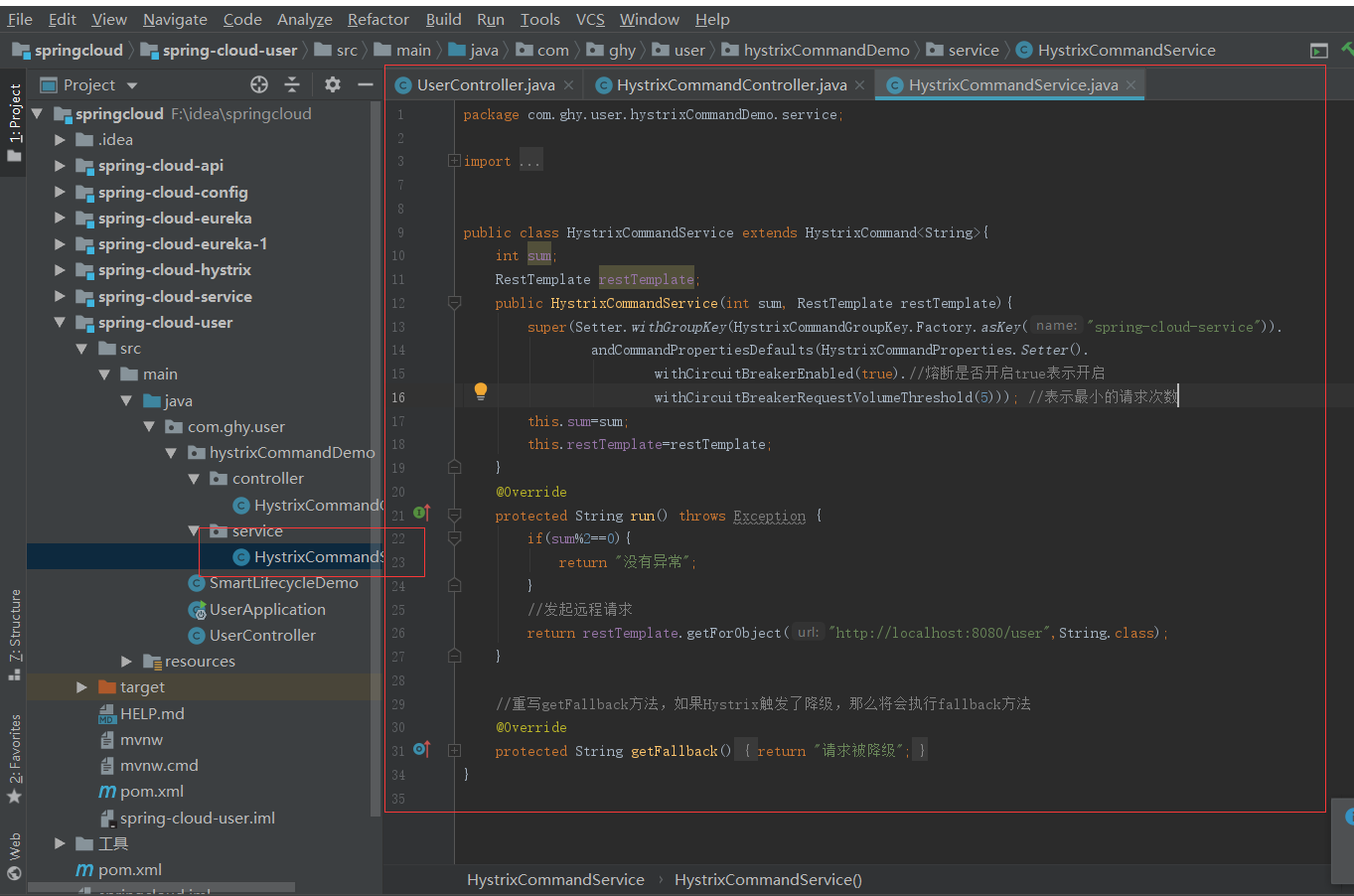
然后启动服务访问浏览器,结果如果我想的一样

2.2、Hystrix是如何工作的
下面演示个带超时降级的Hystrix注解
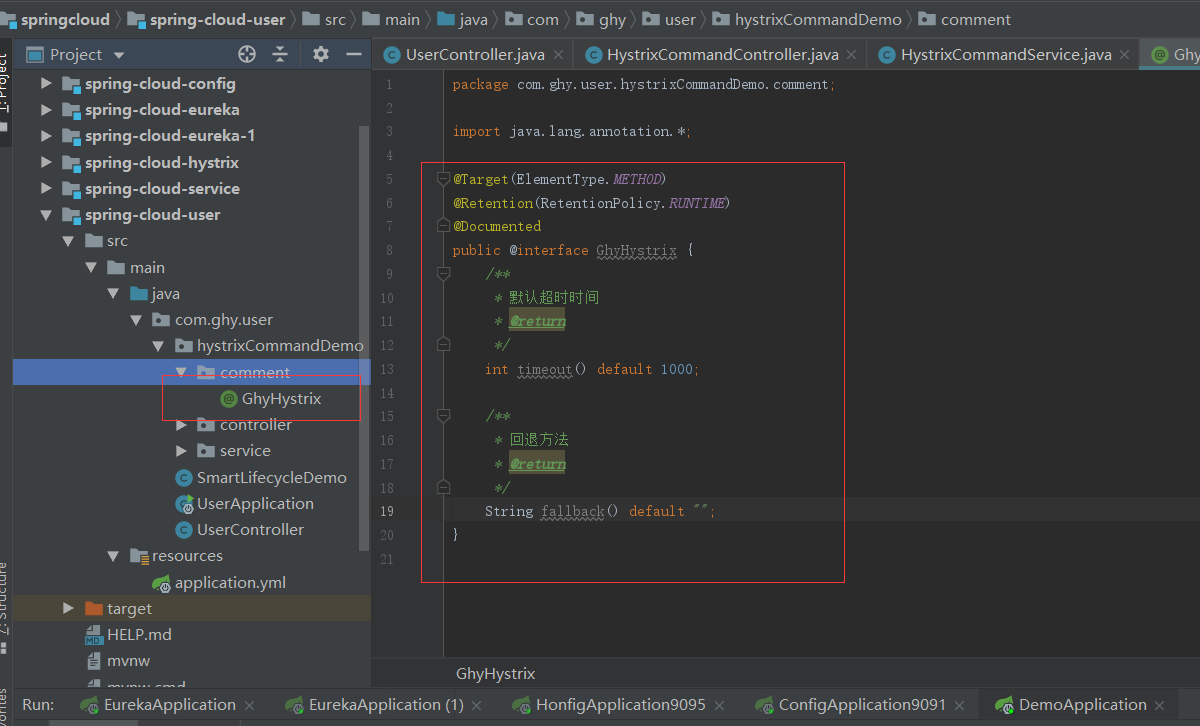
然后用AOP写自己的拦截规则
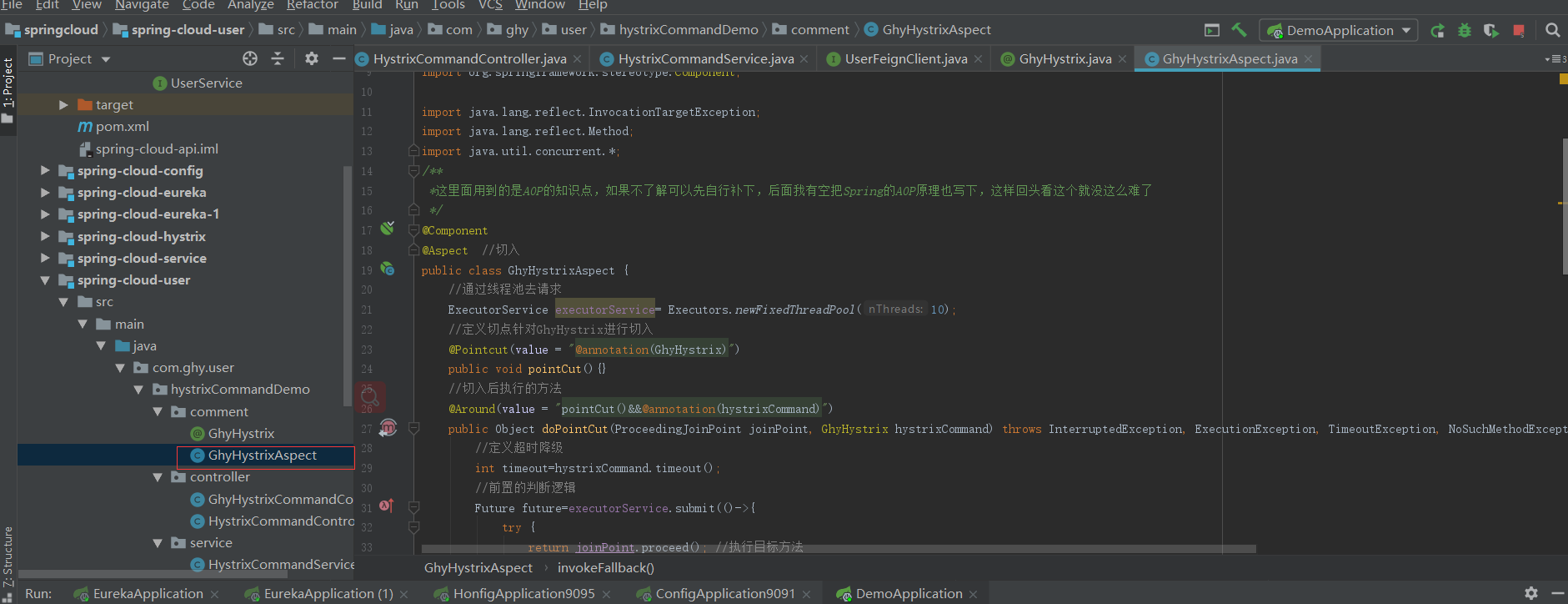
/** *这里面用到的是AOP的知识点,如果不了解可以先自行补下,后面我有空把Spring的AOP原理也写下,这样回头看这个就没这么难了 */ @Component @Aspect //切入 public class GhyHystrixAspect { //通过线程池去请求 ExecutorService executorService= Executors.newFixedThreadPool(10); //定义切点针对GhyHystrix进行切入 @Pointcut(value = "@annotation(GhyHystrix)") public void pointCut(){} //切入后执行的方法 @Around(value = "pointCut()&&@annotation(hystrixCommand)") public Object doPointCut(ProceedingJoinPoint joinPoint, GhyHystrix hystrixCommand) throws InterruptedException, ExecutionException, TimeoutException, NoSuchMethodException, InvocationTargetException, IllegalAccessException { //定义超时降级 int timeout=hystrixCommand.timeout(); //前置的判断逻辑 Future future=executorService.submit(()->{ try { return joinPoint.proceed(); //执行目标方法 } catch (Throwable throwable) { throwable.printStackTrace(); } return null; }); Object result; try { //得到开始和结束时间判断是否超时,如果超时就降级 result=future.get(timeout, TimeUnit.MILLISECONDS); } catch (InterruptedException | ExecutionException | TimeoutException e) { e.printStackTrace(); //超时了就取消请求 future.cancel(true); // 先判断是否为空如果空就把异常抛出去 if(StringUtils.isBlank(hystrixCommand.fallback())){ throw e; } //调用fallback result=invokeFallback(joinPoint,hystrixCommand.fallback()); } return result; } //反射调用 private Object invokeFallback(ProceedingJoinPoint joinPoint,String fallback) throws NoSuchMethodException, InvocationTargetException, IllegalAccessException { MethodSignature signature=(MethodSignature)joinPoint.getSignature(); //拿到方法的信息 Method method=signature.getMethod(); //得到参数类型 Class<?>[] parameterTypes=method.getParameterTypes(); //以上是获取被代理的方法的参数和Method //得到fallback方法 try { Method fallbackMethod=joinPoint.getTarget().getClass().getMethod(fallback,parameterTypes); fallbackMethod.setAccessible(true); //完成反射调用 return fallbackMethod.invoke(joinPoint.getTarget(),joinPoint.getArgs()); } catch (Exception e) { e.printStackTrace(); throw e; } } }
然后再写个调用逻辑,用自己定义的注解
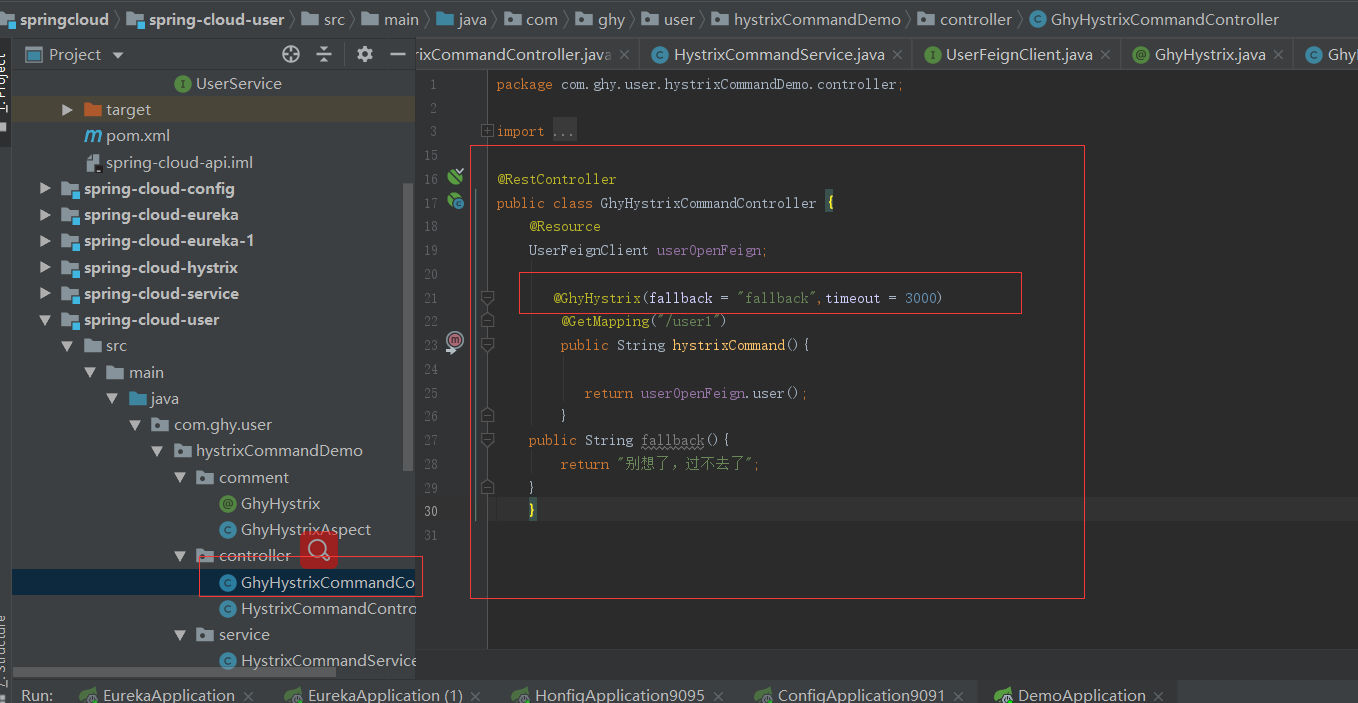
浏览器访问,返回的不是我们刚刚定义的降级内容,其实这也挺好想的,我用的是之前的项目,之前在spring-cloud-api工程中定义了熔断规则,改一下就好
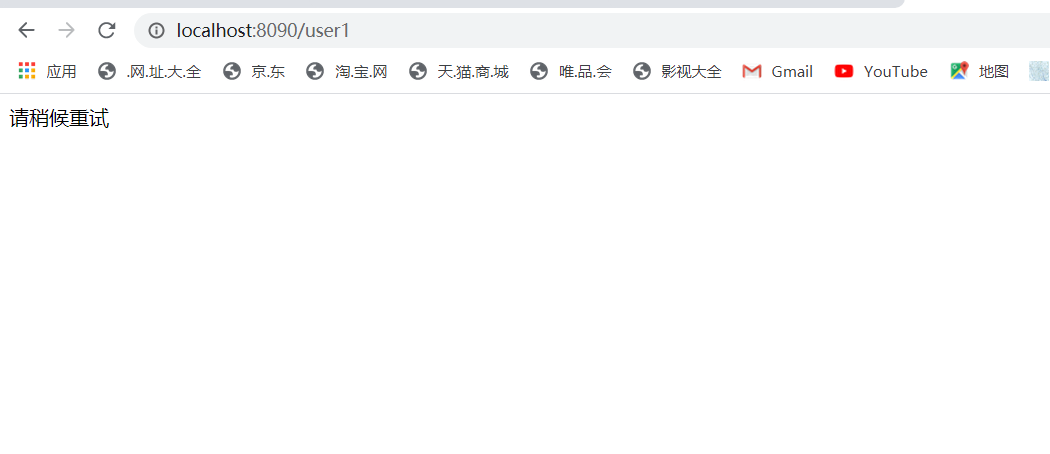
将这此内容改下就好,还有配置文件隐藏下,这里就不搞了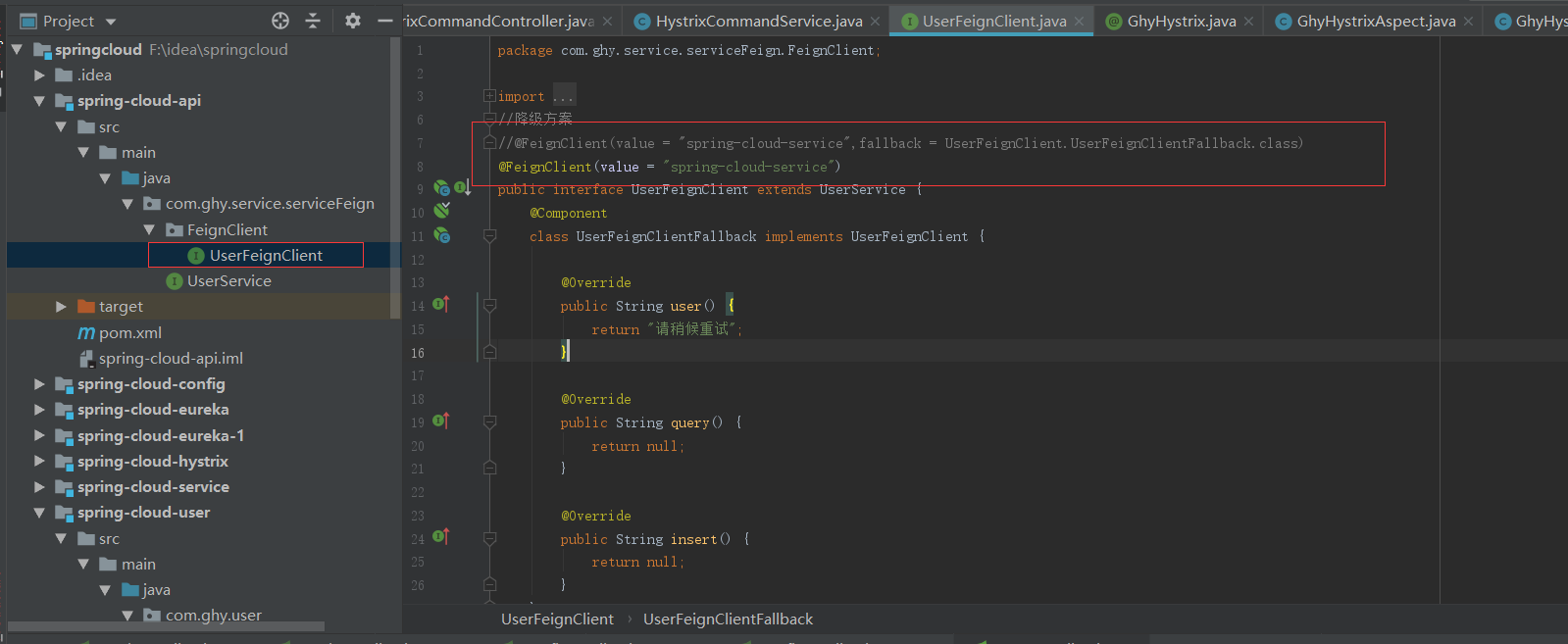
三、Hystrix的熔断的原理以及请求代理的原理
当请求过来时,如果请求失败,先判断请求次数是否达到了最小请求次数,再判断错误率是否达到了阈值,如果没达到就继续请求,这个错误率的统计时间默认是10S;如果达到了阈值就要打开断路器,打开断 路器后有5秒的时间是熔断状态,5秒后,如果有请求过来,就会试着把请求发送到远程服务,如果成功,断路器就关闭;如果失败断路器继续开启;这个流程就引出第一个概念,那就是滑动窗口
3.1、滑动窗口
在 hystrix 里,大量使用了 RxJava 这个响应式函数编程框架,滑动窗口的实现也是使用了 RxJava 框架。它其实就是一个 流量控制技术;竟然提到了滑动窗口,那就必须要提两上东西,一个是计数器,另一个就是滑动窗口;为了更通俗的理解计数器和滑动窗口关系,就以一个例子说明;假如有一个场景:要做一个请求限制,限制要求一分钟内最多只能有60个请求通过,这时最通用的做方就是用个计数器,计数一分钟内请求的次数,在这一分钟内每来一个请求计数器就加1;一分钟过后进入下一个一分钟时计数器就把计数归零重新计数;所以说如果要限流判断就只用判断这一分钟内的计数量就可以了,但这种做法在每个1分钟的临界值时是有问题的,问题是啥呢,假如说在0到58S时都没有请求,但是突然在第59S时一下子来了60个请求,在60S时再来60个请求,这个时候发生的情况是在相邻两秒内一下子来了120个请求,此时因为59S在第一个时间段;60S在第二个时间段,所以没有满足触发熔断条件,这就导至了相邻两秒间的请求量过了阈值,系统很可能炸了,为此引出了另一个玩意,那就是滑动窗口;滑动窗口把一分钟分成6个窗口,每个窗口是10S,红色框代表可以滑动的滑动窗口,黑色的窗口代表10S的统计数值,第一个10S统计 完成后红色滑动窗口会向前滑动一格,改成滑动窗口后他统计的就是红色滑动窗口内的访问量总和了

hystrix是通过滑动窗口统计的,他一共有10个窗口,每个窗口代表1S,所以他统计的是他10S内的数据

上图的每个小矩形代表一个桶,可以看到,每个桶都记录着1秒内的四个指标数据:成功量、失败量、超时量和拒绝量,这里的拒绝量指的就是上面流程图中【信号量/线程池资源检查】中被拒绝的流量。10个桶合起来是一个完整的滑动窗口,所以计算一个滑动窗口的总数据需要将10个桶的数据加起来。
四、Hystrix熔断的源码分析
Hystrix熔断的@HystrixCommand注解,是通过HystrixCommandAspect这个切面来处理的。其中关注@Around注解声明的方法,它针对于请求合并,以及降级的注解进行代理。这里重点针对HystrixCommand这个注解进行详细分析。
- getMethodFromTarget 获取目标方法信息
- MetaHolder metaHolder = metaHolderFactory.create(joinPoint); 获取元数据,比如调用方法,HystrixProperty注解数据、方法参数等
- HystrixCommandFactory.getInstance().create 获取调用者,它持有一个命令对象,并且可以在合适的时候通过这个命令对象完成具体的业务逻辑
- execute,执行命令
@Around("hystrixCommandAnnotationPointcut() || hystrixCollapserAnnotationPointcut()") public Object methodsAnnotatedWithHystrixCommand(final ProceedingJoinPoint joinPoint) throws Throwable { Method method = getMethodFromTarget(joinPoint); //省略代码... MetaHolderFactory metaHolderFactory = META_HOLDER_FACTORY_MAP.get(HystrixPointcutType.of(method)); MetaHolder metaHolder = metaHolderFactory.create(joinPoint); //如果是异步,则创建GenericObservableCommand, 否则,则创建GenericCommand HystrixInvokable invokable = HystrixCommandFactory.getInstance().create(metaHolder); ExecutionType executionType = metaHolder.isCollapserAnnotationPresent() ? metaHolder.getCollapserExecutionType() : metaHolder.getExecutionType(); Object result; try { if (!metaHolder.isObservable()) { //是否是响应式的(由于我们这些都是同步的会走 这个逻辑)
//默认是走这里面,用命令执行器去执行 result = CommandExecutor.execute(invokable, executionType, metaHolder); } else { result = executeObservable(invokable, executionType, metaHolder); } } catch (HystrixBadRequestException e) { throw e.getCause(); } catch (HystrixRuntimeException e) { throw hystrixRuntimeExceptionToThrowable(metaHolder, e); } return result; }
点击进入 CommandExecutor类的execute方法,这个方法主要用来执行命令,从代码中可以看出这里有三个执行类型,分别是同步、异步、以及响应式。其中,响应式又分为Cold Observable(observable.toObservable()) 和 HotObservable(observable.observe())
默认的executionType=SYNCHRONOUS ,同步请求。
- execute():同步执行,返回一个单一的对象结果,发生错误时抛出异常。
- queue():异步执行,返回一个 Future 对象,包含着执行结束后返回的单一结果。
- observe():这个方法返回一个 Observable 对象,它代表操作的多个结果,但是已经被订阅者消费掉了。
- toObservable():这个方法返回一个 Observable 对象,它代表操作的多个结果,需要咱们自己手动订阅并消费掉。
需要注意的是,Hystrix用到了RxJava这个框架,它是一个响应式编程框架,在Android里面用得比较多
public static Object execute(HystrixInvokable invokable, ExecutionType executionType, MetaHolder metaHolder) throws RuntimeException { Validate.notNull(invokable); Validate.notNull(metaHolder); switch (executionType) {
case SYNCHRONOUS: { return castToExecutable(invokable, executionType).execute(); } case ASYNCHRONOUS: { HystrixExecutable executable = castToExecutable(invokable, executionType); if (metaHolder.hasFallbackMethodCommand() && ExecutionType.ASYNCHRONOUS == metaHolder.getFallbackExecutionType()) { return new FutureDecorator(executable.queue()); } return executable.queue(); } case OBSERVABLE: { HystrixObservable observable = castToObservable(invokable); return ObservableExecutionMode.EAGER == metaHolder.getObservableExecutionMode() ? observable.observe() : observable.toObservable(); } default: throw new RuntimeException("unsupported execution type: " + executionType); } }
因为是走默认的,所以进入HystrixCommand类的execute()方法;这个方法中,首先调用queue(),这个方法会返回一个future对象。
public R execute() { try { return queue().get(); } catch (Exception e) { throw Exceptions.sneakyThrow(decomposeException(e)); } }
queue这个方法中,返回了一个Future对象,这个future对象的实现是f,f是以匿名内部类,它是Java.util.concurrent中定一个的一个异步带返回值对象。当调用queue().get()方法时,最终是委派给了delegate.get 方法。
public Future<R> queue() { /* * The Future returned by Observable.toBlocking().toFuture() does not implement the * interruption of the execution thread when the "mayInterrupt" flag of Future.cancel(boolean) is set to true; * thus, to comply with the contract of Future, we must wrap around it. */ final Future<R> delegate = toObservable().toBlocking().toFuture(); final Future<R> f = new Future<R>() { @Override public boolean cancel(boolean mayInterruptIfRunning) { if (delegate.isCancelled()) { return false; } if (HystrixCommand.this.getProperties().executionIsolationThreadInterruptOnFutureCa ncel().get()) { /* * The only valid transition here is false -> true. If there are two futures, say f1 and f2, created by this command * (which is super-weird, but has never been prohibited), and calls to f1.cancel(true) and to f2.cancel(false) are * issued by different threads, it's unclear about what value would be used by the time mayInterruptOnCancel is checked. * The most consistent way to deal with this scenario is to say that if *any* cancellation is invoked with interruption, * than that interruption request cannot be taken back. */ interruptOnFutureCancel.compareAndSet(false, mayInterruptIfRunning); } final boolean res = delegate.cancel(interruptOnFutureCancel.get()); if (!isExecutionComplete() && interruptOnFutureCancel.get()) { final Thread t = executionThread.get(); if (t != null && !t.equals(Thread.currentThread())) { t.interrupt(); } } return res; } @Override public boolean isCancelled() { return delegate.isCancelled(); } @Override public boolean isDone() { return delegate.isDone(); }
//最终会调用此方法 @Override public R get() throws InterruptedException, ExecutionException { return delegate.get(); } @Override public R get(long timeout, TimeUnit unit) throws InterruptedException, ExecutionException, TimeoutException { return delegate.get(timeout, unit); } }; /* special handling of error states that throw immediately */ if (f.isDone()) { try { f.get(); return f; } catch (Exception e) { Throwable t = decomposeException(e); if (t instanceof HystrixBadRequestException) { return f; } else if (t instanceof HystrixRuntimeException) { HystrixRuntimeException hre = (HystrixRuntimeException) t; switch (hre.getFailureType()) { case COMMAND_EXCEPTION: case TIMEOUT: // we don't throw these types from queue() only from queue().get() as they are execution errors return f; default: // these are errors we throw from queue() as they as rejection type errors throw hre; } } else { throw Exceptions.sneakyThrow(t); } } } return f; }
因为最终是委派给了delegate.get 方法执行,而delegate在开头final Future<R> delegate = toObservable().toBlocking().toFuture();中,所以进入toObservable()方法中,在RxJava中,分为几种角色
- Observable(被观察者),它的主要作用是产生事件
- Observer(观察者),它的作用是接收事件并作出相应
- Subscribe(订阅),它用来连接被观察者和观察者
- Event(事件),被观察者、观察者、沟通的载体
在queue中,调用toObservable()方法创建一个被观察者。通过Observable定义一个被观察者,这个被观察者会被toObservable().toBlocking().toFuture() ,实际上就是返回可获得 run() 抽象方法执行结果的Future 。 run() 方法由子类实现,执行正常的业务逻辑。在下面这段代码中,当存在subscriber时,便会调用Func0#call() 方法,而这个subscriber是在 toBlocking() 中被订阅的。
- 调用 isRequestCachingEnabled(); 判断请求结果缓存功能是否开启,如果开启并且命中了缓存,则会以Observable形式返回一个缓存结果
- 创建执行命令的Observable: hystrixObservable
- 当缓存处于开启状态并且没有命中缓存时,则创建一个“订阅了执行命令的Observable”:HystrixCommandResponseFromCache
- 创建存储到缓存的Observable: HystrixCachedObservable
- 将toCache添加到缓存中,返回获取缓存的Observable:fromCache
- 如果添加失败: fromCache!=null, 则调用 toCache.unsubscribe() 方法,取消HystrixCachedObservable 的订阅
- 如果添加成功,则调用 toCache.toObservable(); 获得缓存Observable
- 当缓存特性没有开启时,则返回执行命令的Observable。
public Observable<R> toObservable() { final AbstractCommand<R> _cmd = this; //doOnCompleted handler already did all of the SUCCESS work //doOnError handler already did all of the FAILURE/TIMEOUT/REJECTION/BAD_REQUEST work final Action0 terminateCommandCleanup = new Action0() { @Override public void call() { if (_cmd.commandState.compareAndSet(CommandState.OBSERVABLE_CHAIN_CREATED, CommandState.TERMINAL)) { handleCommandEnd(false); //user code never ran } else if (_cmd.commandState.compareAndSet(CommandState.USER_CODE_EXECUTED, CommandState.TERMINAL)) { handleCommandEnd(true); //user code did run } } }; //mark the command as CANCELLED and store the latency (in addition to standard cleanup) final Action0 unsubscribeCommandCleanup = new Action0() { @Override public void call() { if (_cmd.commandState.compareAndSet(CommandState.OBSERVABLE_CHAIN_CREATED, CommandState.UNSUBSCRIBED)) { if (!_cmd.executionResult.containsTerminalEvent()) { _cmd.eventNotifier.markEvent(HystrixEventType.CANCELLED, _cmd.commandKey); try { executionHook.onUnsubscribe(_cmd); } catch (Throwable hookEx) { logger.warn("Error calling HystrixCommandExecutionHook.onUnsubscribe", hookEx); } _cmd.executionResultAtTimeOfCancellation = _cmd.executionResult .addEvent((int) (System.currentTimeMillis() - _cmd.commandStartTimestamp), HystrixEventType.CANCELLED); } handleCommandEnd(false); //user code never ran } else if (_cmd.commandState.compareAndSet(CommandState.USER_CODE_EXECUTED, CommandState.UNSUBSCRIBED)) { if (!_cmd.executionResult.containsTerminalEvent()) { _cmd.eventNotifier.markEvent(HystrixEventType.CANCELLED, _cmd.commandKey); try { executionHook.onUnsubscribe(_cmd); } catch (Throwable hookEx) { logger.warn("Error calling HystrixCommandExecutionHook.onUnsubscribe", hookEx); } _cmd.executionResultAtTimeOfCancellation = _cmd.executionResult .addEvent((int) (System.currentTimeMillis() - _cmd.commandStartTimestamp), HystrixEventType.CANCELLED); } handleCommandEnd(true); //user code did run } } }; final Func0<Observable<R>> applyHystrixSemantics = new Func0<Observable<R>>() { @Override public Observable<R> call() { if (commandState.get().equals(CommandState.UNSUBSCRIBED)) { return Observable.never(); } return applyHystrixSemantics(_cmd); } }; final Func1<R, R> wrapWithAllOnNextHooks = new Func1<R, R>() { @Override public R call(R r) { R afterFirstApplication = r; try { afterFirstApplication = executionHook.onComplete(_cmd, r); } catch (Throwable hookEx) { logger.warn("Error calling HystrixCommandExecutionHook.onComplete", hookEx); } try { return executionHook.onEmit(_cmd, afterFirstApplication); } catch (Throwable hookEx) { logger.warn("Error calling HystrixCommandExecutionHook.onEmit", hookEx); return afterFirstApplication; } } }; final Action0 fireOnCompletedHook = new Action0() { @Override public void call() { try { executionHook.onSuccess(_cmd); } catch (Throwable hookEx) { logger.warn("Error calling HystrixCommandExecutionHook.onSuccess", hookEx); } } }; return Observable.defer(new Func0<Observable<R>>() { @Override public Observable<R> call() { /* this is a stateful object so can only be used once */ /* CAS保证命令只执行一次 */ if (!commandState.compareAndSet(CommandState.NOT_STARTED, CommandState.OBSERVABLE_CHAIN_CREATED)) { IllegalStateException ex = new IllegalStateException("This instance can only be executed once. Please instantiate a new instance."); //TODO make a new error type for this throw new HystrixRuntimeException(FailureType.BAD_REQUEST_EXCEPTION, _cmd.getClass(), getLogMessagePrefix() + " command executed multiple times - this is not permitted.", ex, null); } // 命令开始时间戳 commandStartTimestamp = System.currentTimeMillis(); // 打印日志 if (properties.requestLogEnabled().get()) { // log this command execution regardless of what happened if (currentRequestLog != null) { currentRequestLog.addExecutedCommand(_cmd); } } // 缓存开关,缓存KEY(这个是Hystrix中请求缓存功能,hystrix支持将一个请求结果缓存起 来,下一个具有相同key的请求将直接从缓存中取出结果,减少请求开销) final boolean requestCacheEnabled = isRequestCachingEnabled(); final String cacheKey = getCacheKey(); /* try from cache first */ if (requestCacheEnabled) {//如果开启了缓存机制,则从缓存中获取结果 HystrixCommandResponseFromCache<R> fromCache = (HystrixCommandResponseFromCache<R>) requestCache.get(cacheKey); if (fromCache != null) { isResponseFromCache = true; return handleRequestCacheHitAndEmitValues(fromCache, _cmd); } } // 声明执行命令的Observable Observable<R> hystrixObservable = Observable.defer(applyHystrixSemantics) .map(wrapWithAllOnNextHooks); Observable<R> afterCache; //保存请求结果到缓存中 if (requestCacheEnabled && cacheKey != null) { // wrap it for caching HystrixCachedObservable<R> toCache = HystrixCachedObservable.from(hystrixObservable, _cmd); HystrixCommandResponseFromCache<R> fromCache = (HystrixCommandResponseFromCache<R>) requestCache.putIfAbsent(cacheKey, toCache); if (fromCache != null) { // another thread beat us so we'll use the cached value instead toCache.unsubscribe(); isResponseFromCache = true; return handleRequestCacheHitAndEmitValues(fromCache, _cmd); } else { // we just created an ObservableCommand so we cast and return it afterCache = toCache.toObservable(); } } else { afterCache = hystrixObservable; } return afterCache .doOnTerminate(terminateCommandCleanup) // perform cleanup once (either on normal terminal state (this line), or unsubscribe (next line)) .doOnUnsubscribe(unsubscribeCommandCleanup) // perform cleanup once .doOnCompleted(fireOnCompletedHook); } });
执行命令的Observable的定义如下,通过defer定义了一个 applyHystrixSemantics 的事件。
final Func0<Observable<R>> applyHystrixSemantics = new Func0<Observable<R>>() { @Override public Observable<R> call() { // 当commandState处于UNSUBSCRIBED时,不执行命令 if (commandState.get().equals(CommandState.UNSUBSCRIBED)) { return Observable.never(); } //返回执行命令的Observable return applyHystrixSemantics(_cmd); } }; Observable<R> hystrixObservable = Observable.defer(applyHystrixSemantics) .map(wrapWithAllOnNextHooks);
applyHystrixSemantics方法;假设缓存特性未开启或者未命中缓存,那么代码将执行 applyHystrixSemantics 。
- 传入的_cmd是一个GenericCommand,最终执行这个command中的run方法,本质就是完成对queryOrder方法的代理
- circuitBreaker.allowRequest() 如果为true,表示当前不处于熔断状态,正常执行,否则,调用 handleShortCircuitViaFallback 实现服务降级,如果我们配置了fallback方法,则会获得我们配置的fallback执行
- 如果当前hystrix处于未熔断状态,则
-
- getExecutionSemaphore 判断当前策略是否为信号量(TryableSemaphoreNoOp/TryableSemaphoreActual),如果是,则调用 tryAcquire 来获取信号量。如果当前信号量满了,则调用 handleSemaphoreRejectionViaFallback 方法。
- 调用 executeCommandAndObserve 获取命令执行Observable。
private Observable<R> applyHystrixSemantics(final AbstractCommand<R> _cmd) { // mark that we're starting execution on the ExecutionHook // if this hook throws an exception, then a fast-fail occurs with no fallback. No state is left inconsistent executionHook.onStart(_cmd); /* determine if we're allowed to execute */ if (circuitBreaker.allowRequest()) { final TryableSemaphore executionSemaphore = getExecutionSemaphore(); final AtomicBoolean semaphoreHasBeenReleased = new AtomicBoolean(false); final Action0 singleSemaphoreRelease = new Action0() { @Override public void call() { if (semaphoreHasBeenReleased.compareAndSet(false, true)) { executionSemaphore.release(); } } }; final Action1<Throwable> markExceptionThrown = new Action1<Throwable>() { @Override public void call(Throwable t) { eventNotifier.markEvent(HystrixEventType.EXCEPTION_THROWN, commandKey); } }; if (executionSemaphore.tryAcquire()) { try { /* used to track userThreadExecutionTime */ executionResult = executionResult.setInvocationStartTime(System.currentTimeMillis());
//跟进 return executeCommandAndObserve(_cmd) .doOnError(markExceptionThrown) .doOnTerminate(singleSemaphoreRelease) .doOnUnsubscribe(singleSemaphoreRelease); } catch (RuntimeException e) { return Observable.error(e); } } else { return handleSemaphoreRejectionViaFallback(); } } else { return handleShortCircuitViaFallback(); } }
executeCommandAndObserve
- 定义不同的回调,doOnNext、doOnCompleted、onErrorResumeNext、doOnEach。
- 调用executeCommandWithSpecifiedIsolation获得执行命令的Observable
- 若执行命令超时特性开启,调用 Observable.lift 方法实现执行命令超时功能。
private Observable<R> executeCommandAndObserve(final AbstractCommand<R> _cmd) { final HystrixRequestContext currentRequestContext = HystrixRequestContext.getContextForCurrentThread(); //Action和Func都是定义的一个动作,Action是无返回值,Func是有返回值 // doOnNext中的回调。即命令执行之前执行的操作 final Action1<R> markEmits //... // doOnCompleted中的回调。命令执行完毕后执行的操作 final Action0 markOnCompleted = //... // onErrorResumeNext中的回调。命令执行失败后的回退逻辑 final Func1<Throwable, Observable<R>> handleFallback = //... // doOnEach中的回调。`Observable`每发射一个数据都会执行这个回调,设置请求上下文 final Action1<Notification<? super R>> setRequestContext =//... Observable<R> execution; if (properties.executionTimeoutEnabled().get()) { execution = executeCommandWithSpecifiedIsolation(_cmd) .lift(new HystrixObservableTimeoutOperator<R>(_cmd)); } else { execution = executeCommandWithSpecifiedIsolation(_cmd); } return execution.doOnNext(markEmits) .doOnCompleted(markOnCompleted) .onErrorResumeNext(handleFallback) .doOnEach(setRequestContext); }
executeCommandWithSpecifiedIsolation方法,这个方法首先是根据当前不同的资源隔离策略执行不同的逻辑,THREAD、SEMAPHORE,这里就不展开实现细节,我们直接看执行的方法 getUserExecutionObservable 。
private Observable<R> executeCommandWithSpecifiedIsolation(final AbstractCommand<R> _cmd) { if (properties.executionIsolationStrategy().get() == ExecutionIsolationStrategy.THREAD) { // mark that we are executing in a thread (even if we end up being rejected we still were a THREAD execution and not SEMAPHORE) return Observable.defer(new Func0<Observable<R>>() { @Override public Observable<R> call() { executionResult = executionResult.setExecutionOccurred(); if (!commandState.compareAndSet(CommandState.OBSERVABLE_CHAIN_CREATED, CommandState.USER_CODE_EXECUTED)) { return Observable.error(new IllegalStateException("execution attempted while in state : " + commandState.get().name())); } metrics.markCommandStart(commandKey, threadPoolKey, ExecutionIsolationStrategy.THREAD); if (isCommandTimedOut.get() == TimedOutStatus.TIMED_OUT) { // the command timed out in the wrapping thread so we will return immediately // and not increment any of the counters below or other such logic return Observable.error(new RuntimeException("timed out before executing run()")); } if (threadState.compareAndSet(ThreadState.NOT_USING_THREAD, ThreadState.STARTED)) { //we have not been unsubscribed, so should proceed HystrixCounters.incrementGlobalConcurrentThreads(); threadPool.markThreadExecution(); // store the command that is being run endCurrentThreadExecutingCommand = Hystrix.startCurrentThreadExecutingCommand(getCommandKey()); executionResult = executionResult.setExecutedInThread(); /** * If any of these hooks throw an exception, then it appears as if the actual execution threw an error */ try { executionHook.onThreadStart(_cmd); executionHook.onRunStart(_cmd); executionHook.onExecutionStart(_cmd); return getUserExecutionObservable(_cmd); } catch (Throwable ex) { return Observable.error(ex); } } else { //command has already been unsubscribed, so return immediately return Observable.error(new RuntimeException("unsubscribed before executing run()")); } } }).doOnTerminate(new Action0() { @Override public void call() { if (threadState.compareAndSet(ThreadState.STARTED, ThreadState.TERMINAL)) { handleThreadEnd(_cmd); } if (threadState.compareAndSet(ThreadState.NOT_USING_THREAD, ThreadState.TERMINAL)) { //if it was never started and received terminal, then no need to clean up (I don't think this is possible) } //if it was unsubscribed, then other cleanup handled it } }).doOnUnsubscribe(new Action0() { @Override public void call() { if (threadState.compareAndSet(ThreadState.STARTED, ThreadState.UNSUBSCRIBED)) { handleThreadEnd(_cmd); } if (threadState.compareAndSet(ThreadState.NOT_USING_THREAD, ThreadState.UNSUBSCRIBED)) { //if it was never started and was cancelled, then no need to clean up } //if it was terminal, then other cleanup handled it } }).subscribeOn(threadPool.getScheduler(new Func0<Boolean>() { @Override public Boolean call() { return properties.executionIsolationThreadInterruptOnTimeout().get() && _cmd.isCommandTimedOut.get() == TimedOutStatus.TIMED_OUT; } })); } else { return Observable.defer(new Func0<Observable<R>>() { @Override public Observable<R> call() { executionResult = executionResult.setExecutionOccurred(); if (!commandState.compareAndSet(CommandState.OBSERVABLE_CHAIN_CREATED, CommandState.USER_CODE_EXECUTED)) { return Observable.error(new IllegalStateException("execution attempted while in state : " + commandState.get().name())); } metrics.markCommandStart(commandKey, threadPoolKey, ExecutionIsolationStrategy.SEMAPHORE); // semaphore isolated // store the command that is being run endCurrentThreadExecutingCommand = Hystrix.startCurrentThreadExecutingCommand(getCommandKey()); try { executionHook.onRunStart(_cmd); executionHook.onExecutionStart(_cmd); return getUserExecutionObservable(_cmd); //the getUserExecutionObservable method already wraps sync exceptions, so this shouldn't throw } catch (Throwable ex) { //If the above hooks throw, then use that as the result of the run method return Observable.error(ex); } } }); } }
调用 getExecutionObservable 方法创建 命令执行Observable 。 getExecutionObservable 方法是个抽象方法, HystrixCommand 实现了该方法。
private Observable<R> getUserExecutionObservable(final AbstractCommand<R> _cmd) { Observable<R> userObservable; try { userObservable = getExecutionObservable(); } catch (Throwable ex) { // the run() method is a user provided implementation so can throw instead of using Observable.onError // so we catch it here and turn it into Observable.error userObservable = Observable.error(ex); } return userObservable .lift(new ExecutionHookApplication(_cmd)) .lift(new DeprecatedOnRunHookApplication(_cmd)); }
调用 HystrixCommand.getExecutionObservable 方法创建命令执行Observable这里最终调用的是run方法,通过Observable.just, just是RxJava中的一个操作符,它可以接受一个或者多个参数来创建一个Observable对象。而这个run()方法是一个抽象方法,在HystrixCommand中并没有实现,而是在子类中实现,而此时传递的cmd=GenricCommand正好实现了HystrixCommand,重写了run方法。
@Override final protected Observable<R> getExecutionObservable() { return Observable.defer(new Func0<Observable<R>>() { @Override public Observable<R> call() { try { return Observable.just(run()); } catch (Throwable ex) { return Observable.error(ex); } } }).doOnSubscribe(new Action0() { @Override public void call() { // Save thread on which we get subscribed so that we can interrupt it later if needed executionThread.set(Thread.currentThread()); } }); }
enericCommand类中的run方法,这里的实现和前面自定义的 HystrixCommandService 实现是一样的,同样是集成HystrixCommand,重写run方法。这里也是如此。
- 首先调用 getCommandAction() 方法获取 CommandAction ,我们的示例中获取到的是MethodExecutionAction 。
- 然后调用 MethodExecutionAction.execute 方法,传入 ExecutionType 参数,我们的示例中传入的是 ExecutionType.SYNCHRONOUS 。
@Override protected Object run() throws Exception { LOGGER.debug("execute command: {}", getCommandKey().name()); return process(new Action() { @Override Object execute() { return getCommandAction().execute(getExecutionType()); } }); }